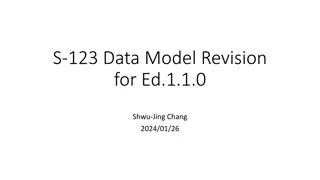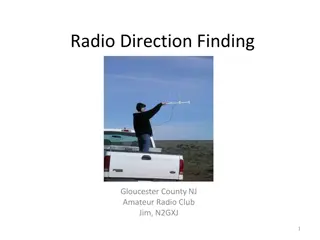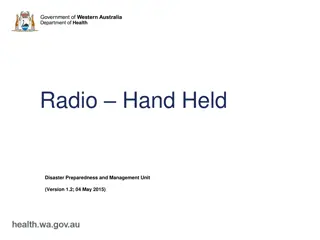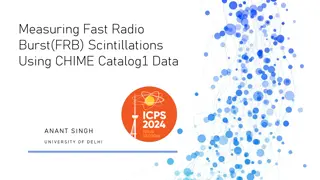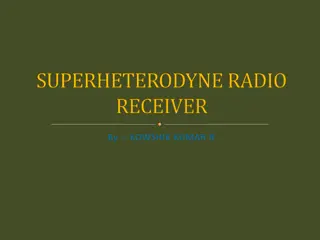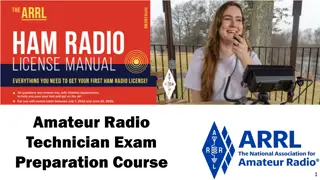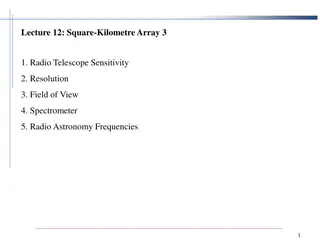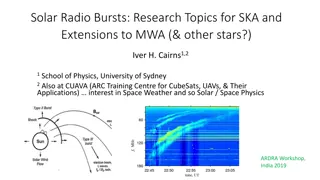Understanding Radio Transmitters: Classifications and Types
This comprehensive guide delves into the world of radio transmitters, covering their classifications based on modulation, service involved, frequency range, and power used. Learn about different types of modulation transmitters, service-specific transmitters, carrier frequency-based transmitters, and AM transmitters. Explore block diagrams of low-level and high-level AM transmitters, as well as a reactance FET FM modulator and Armstrong FM transmitter method. Enhance your knowledge of communication systems with detailed insights and visual aids.
Download Presentation

Please find below an Image/Link to download the presentation.
The content on the website is provided AS IS for your information and personal use only. It may not be sold, licensed, or shared on other websites without obtaining consent from the author. Download presentation by click this link. If you encounter any issues during the download, it is possible that the publisher has removed the file from their server.
E N D
Presentation Transcript
Classification of Radio Transmitters 1. According to the type of modulation used. 2. According to the service involved. 3. According to the frequency range used. 4. According to the power used.
According to the type of modulation used 1. Amplitude Modulation Transmitters 2. Frequency Modulation Transmitters 3. Pulse Modulation Transmitters
Classification of Radio Transmitters According to the service involved 1.Radio Broadcast Transmitters 2.Radio Telephony Transmitters 3. Radio Telegraph Transmitters 4.Television Transmitters 5.Radar Transmitters 6.Navigational Transmitters
Classification of Radio Transmitters According to the type of Carrier frequency 1. Long Wave Transmitters 2. Medium Wave Transmitters 3. Short Wave Transmitters 4.V.H.F and U.H.F Transmitters 5. Microwave Transmitters
Classification of Radio Transmitters According to the power used 1.Low level Modulated AM Transmitters 2.High level Modulated AM Transmitters
Types of AM Transmitters 1. Low level AM Transmitters 2. High level AM Transmitters
Block Diagram of High level AM Transmitters
Armstrong FM Transmitter The direct methods cannot be used for the broadcast applications. Thus the alternative method i.e. indirect method called as the Armstrong method of FM generation is used. In this method the FM is obtained through phase modulation. A crystal oscillator can be used hence the frequency stability is very high.
BD of Superhetrodyne AM Radio Receiver
RF tuning & amplification: This RF stage within the overall block diagram for the receiver provides initial tuning to remove the image signal. It also provides some amplification. If noise performance for the receiver is important, then this stage will be designed for optimum noise performance. This RF amplifier circuit block will also increase the signal level so that the noise introduced by later stages is at a lower level in comparison to the wanted signal. Local oscillator: The local oscillator circuit block can take a variety of forms. Early receivers used free running local oscillators. Today most receivers use frequency synthesizers, normally based around phase locked loops. These provide much greater levels of stability and enable frequencies to be programmed in a variety of ways.
Mixer: Both the local oscillator and incoming signal enter this block within the Superhetrodyne receiver. The wanted signal is converted to the intermediate frequency. IF amplifier & filter: This Superhetrodyne receiver block provides the majority of gain and selectivity. High performance filters like crystal filters may be used, although LC or ceramic filters may be used within domestic radios.
Demodulator: The Superhetrodyne receiver block diagram only shows one demodulator, but in reality radios may have one or more demodulators dependent upon the type of signals being receiver. Audio amplifier: Once demodulated, the recovered audio is applied to an audio amplifier block to be amplified to the required level for loudspeakers or headphones. Alternatively the recovered modulation may be used for other applications whereupon it is processed in the required way by a specific circuit block.
ANTENNA In radio, an antenna is the interface between radio waves propagating through space and electric currents moving in metal conductors, used with a transmitter or receiver.[1] In transmission, a radio transmitter supplies an electric current to the antenna's terminals, and the antenna radiates the energy from the current as electromagnetic waves (radio waves). In reception, an antenna intercepts some of the power of an electromagnetic wave in order to produce an electric current at its terminals, that is applied to a receiver to be amplified. Antennas are essential components of all radio equipment, and are used in radio broadcasting, broadcast television, two-way radio, communications receivers, radar, cell phones, satellite communications and other devices.
DIPOLE The dipole is the prototypical antenna on which a large class of antennas are based. A basic dipole antenna consists of two conductors (usually metal rods or wires) arranged symmetrically, with one side of the balanced feedline from the transmitter or receiver attached to each.[18][21] The most common type, the half-wave dipole, consists of two resonant elements just under a quarter wavelength long. This antenna radiates maximally in directions perpendicular to the antenna's axis,
ANTENNA ARRAY Array antennas consist of multiple antennas working as a single antenna. Typically they consist of arrays of identical driven elements, usually dipoles fed in phase, giving increased gain over that of a single dipole. Collinear - Consist of a number of dipoles in a vertical line. It is a high gain omnidirectional antenna, meaning more of the power is radiated in horizontal directions and less into the sky or ground and wasted. Gain of 8 to 10 dBi. Used as base station antennas for land mobile radio systems such as police, fire, ambulance, and taxi dispatchers, and sector antennas for cellular base stations.
The Electromagnetic Spectrum Frequency Range Band Designation 30-3000 Hz ELF 3-30 kHz VLF 30-300 kHz LF 300-3000 kHz MF 3-30 MHz HF 30-300 MHz VHF 300-3000 MHz UHF 3-30 GHz SHF 30-300 GHz EHF
Ground Wave Propagation Radio waves in the VLF band propagate in a ground, or surface wave. The wave is connected at one end to the surface of the earth and to the ionosphere at the other.The ionosphere is the region above the troposphere (where the air is), from about 50 to250 miles above the earth. It is a collection of ions, which are atoms that have someof their electrons stripped off leaving two or more electrically charged objects.The sun's rays cause the ions to form which slowly recombine. The propagation of radiowaves in the presence of ions is drastically different than in air, which is why theionosphere plays an important role in most modes of propagation. Ground waves travelbetween two limits, the earth and the ionosphere,
PCM Pulse code modulation (PCM) is a digital representation of an analog signal that takes samples of the amplitude of the analog signal at regular intervals. The sampled analog data is changed to, and then represented by, binary data. PCM requires a very accurate clock. The number of samples per second, ranging from 8,000 to 192,000, is usually several times the maximum frequency of the analog waveform in Hertz (Hz), or cycles per second, which ranges from 8 to 192 KHz.



